Recently we’ve noticed an increase of errors in our static analysis for Android applications in Triage, preventing the initial handling from working as expected. All of the issues are around parsing the APK file uploaded, which we do as part of the process to extract the manifest and other relevant files to examine. For example:
could not process APK: zip: unsupported compression algorithmcould not process APK: unexpected chunk typecould not process APK: zip: checksum errorcould not process APK: unexpected EOFcould not decode AXML: unexpected chunk typecould not decode AXML: sblock: string with idx 268435468 not foundcould not decode AXML: EOF
At first we believed the malware author had simply modified some file header in error, causing static analysis to fail, and that dynamic analysis would not be successfully installed and executed as it is not a valid APK. Interestingly however, this specific type of Android application can be installed and executed by the virtual machine. This indicated that the Android device can correctly recognize the content within the APK file despite the apparent malformity, allowing the Android device or the Android virtual machine to run smoothly without any errors. On investigation it became clear that the issue is not at all limited to Triage - that is to say, this technique allows malware to infect Android devices while evading most static analysis tools.
When attempting to analyze specific APK files using static analysis tools such as apkanalyzer, apktool, or Jadx, you may encounter errors that prevent successful file opening. Even if you try to use a decompression tool to decompress and extract the files inside, you may find that the files cannot be properly decompressed.
Recent research conducted by Zimperium, Kaspersky, Fortinet, and Palo Alto Networks shows that this particular technique has been in use for several years. Based on the submissions we see to our public Triage platform, there has recently been a rise in its popularity with an increasing number of malware families employing this anti-static analysis technique to evade detection and remain installable on Android devices.
This kind of anti-static analysis technique commonly targets the APK and AndroidManifest.xml. These files are essential inputs and entry points for analyzing malware behavior and associated information. The use of these techniques poses challenges for malware analysts, as it increases both analysis time and effort and can cause most automatic reverse engineering tools to fail in accessing the content.
However with the help of the Triage sandbox we can now support these anti-static analysis techniques more effectively, overcoming these challenges and extending our signatures to detect malformed APKs.
Technical Analysis
This anti-static analysis mainly focuses on two file formats: APK and AXML (Android binary XML).
Malformed APK
The technique for APK involves modifying specific headers based on the ZIP format, which commonly includes the compression method and other header information. These modifications impact static analysis tools and may cause errors when parsing the APK or the AndroidManifest.xml. Additionally, attempts to decompress and extract the AndroidManifest.xml file for separate analysis also fail due to its malformed headers.
Compression method of the APK
When encountering the unsupported compression algorithm error in an APK analysis, it’s typically due to the modification of its compression method. Android devices only recognize two compression methods – DEFLATED (0x0008) or STORED (0x0000) - when installing an APK. If the value of the compression method is neither of these it defaults to STORED, which means no compression. Other static analysis tools may display an error message if the APK includes a non-standard decompression method.
Other common fields that may be modified
In addition to the compression method field, we also observed that other fields may be modified by malware.
Local File Header:
- Version needed to extract
- General purpose bit flag
- Compression method
- CRC-32 checksum
- Compressed size
- Uncompressed size
- File name
Central Directory File Header:
- Version made by
- Version needed to extract
- General purpose bit flag
- Compression method
- CRC-32 checksum
- Compressed size
- Uncompressed size
- File name
Malformed AXML
The technique for AXML involves modifying some fields in its header within the AndroidManifest.xml file. It includes modifying the magic number, string count in the string pool, unexpected attribute names and attribute size, and inserting invalid data between XML elements. These tricks allow the file to evade static analysis tools while still being readable by the Android system. It works because static analysis tools and the Android system handle it differently, similar to the APK trick. Some fields may be modified by malware as follows:
- Magic number
- StringCount in strPool
- Attribute names
- Attribute size
- Invalid data between XML elements
- Namespace end node size
Example
Let’s analyze the techniques mentioned above and how they are utilized in real malware that we found from public triage. We found this sample by searching for unsupported compression algorithms. After further investigation, we found that it is actually another obfuscated SpyNote sample. This sample contains an embedded APK that prompts the victim to install it after launching the application. In the static report, we observed two errors that caught our attention and seemed worth investigating.

SHA256: 26f0a9ba3832d464e2b26ad4f30b0e431221fbb99081ec0c833fa00976446023 (View Report)
If you attempt to analyze this sample using Jadx or other decompilation tools you may notice that while you can see the decompiled code, the AndroidManifest.xml is not available and most tools fail to open it correctly. However, if you use JEB, it does a great job with this sample and provides a clear output. Since we want to know exactly what’s behind it, let’s do it the hard way.

Obfuscated Directory Name
When utilizing the unzip command for the APK, you will notice the first trick: the obfuscated directory name causes errors with the unzip command. The malware attempts to treat AndroidManifest.xml and classes.dex as directories, even though they are actually files.
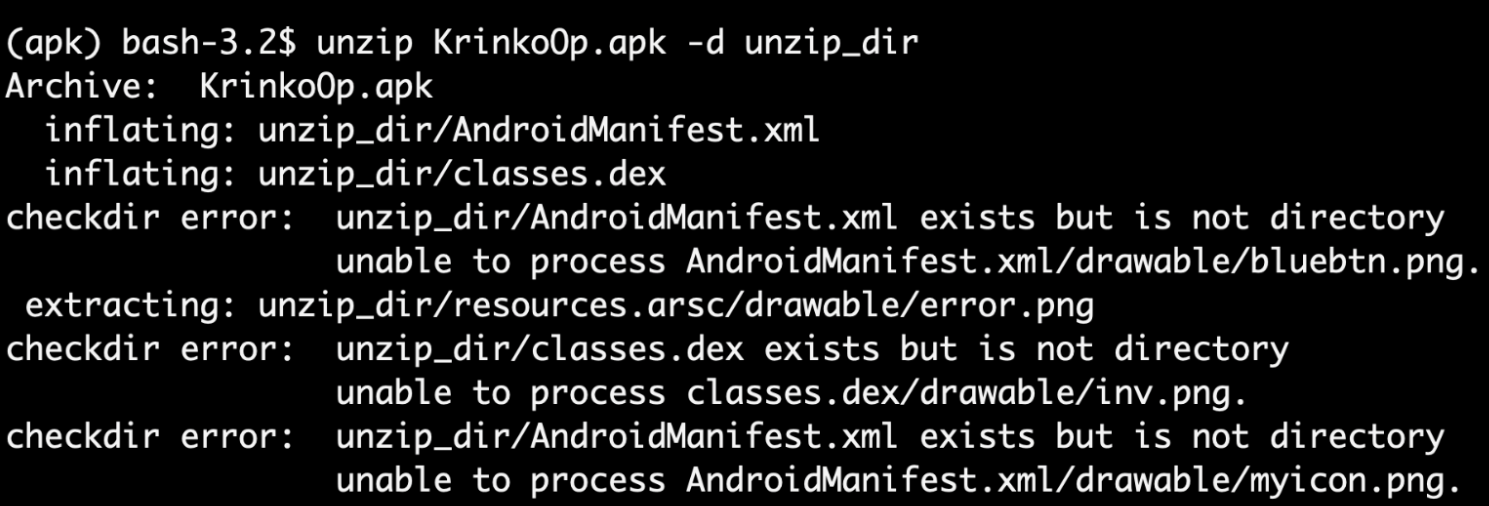

If you open it with 010Editor, you can easily find this modified filename in the file name fields within both the Local File Header and Central Directory File Header. However since we only need to analyze the AndroidManifest.xml, we can extract it separately using the command below and make sure you get the proper permission for that.
unzip -p KrinkoOp.apk AndroidManifest.xml > AndroidManifest.xml
Unexpected Attribute Names and Attribute Size
Moving forward to address the error encountered when attempting to access the AndroidManifest.xml file. In the screenshot from Jadx above we see this error message:
Error decode manifest
java.io.IOException: Decode error: startNS's attributeSize is not 0x14, position: 0x16fc
at jadx.core.xmlgen.CommonBinaryParser.die(CommonBinaryParser.java:39)
at jadx.core.xmlgen.BinaryXMLParser.parseElement(BinaryXMLParser.java:269)
at jadx.core.xmlgen.BinaryXMLParser.decode(BinaryXMLParser.java:132)
at jadx.core.xmlgen.BinaryXMLParser.parse(BinaryXMLParser.java:87)
This tells us that the attributeSize is not 0x14, and the error occurs when the position is read to 0x16fc. Let’s use 010Editor to check this position.

The ResourceTypes definition states that the attributeSize should be 20 (0x14) bytes. However, it has been changed to 24 bytes, resulting in an error. Additionally, there seems to be an issue with the total size of this element. The header defines the total size of this element as 204 bytes.
However the header size is 16 bytes, the size of ResXMLTree_attrExt is 20 bytes, and the size of ResXMLTree_attribute is 20 bytes. With 7 attributes here, we can calculate the total size of this element as follows:
header + ResXMLTree_attrExt + ResXMLTree_attribute * 7
This equals 16 + 20 + (20 * 7) = 176 bytes, which means there are 28 redundant bytes within this element.

After manually fixing the incorrect sizes, we reopened the file using Jadx but encountered the same issue in a different position as stated in the error message below. It seems that more than one element had its size modified.
After correcting all the modified sizes and reopening the file with Jadx, everything is now functioning properly, as shown in the screenshot below. While some attribute names are missing from Jadx it can still show an overview of AndroidManifest.xml and access most of its contents.
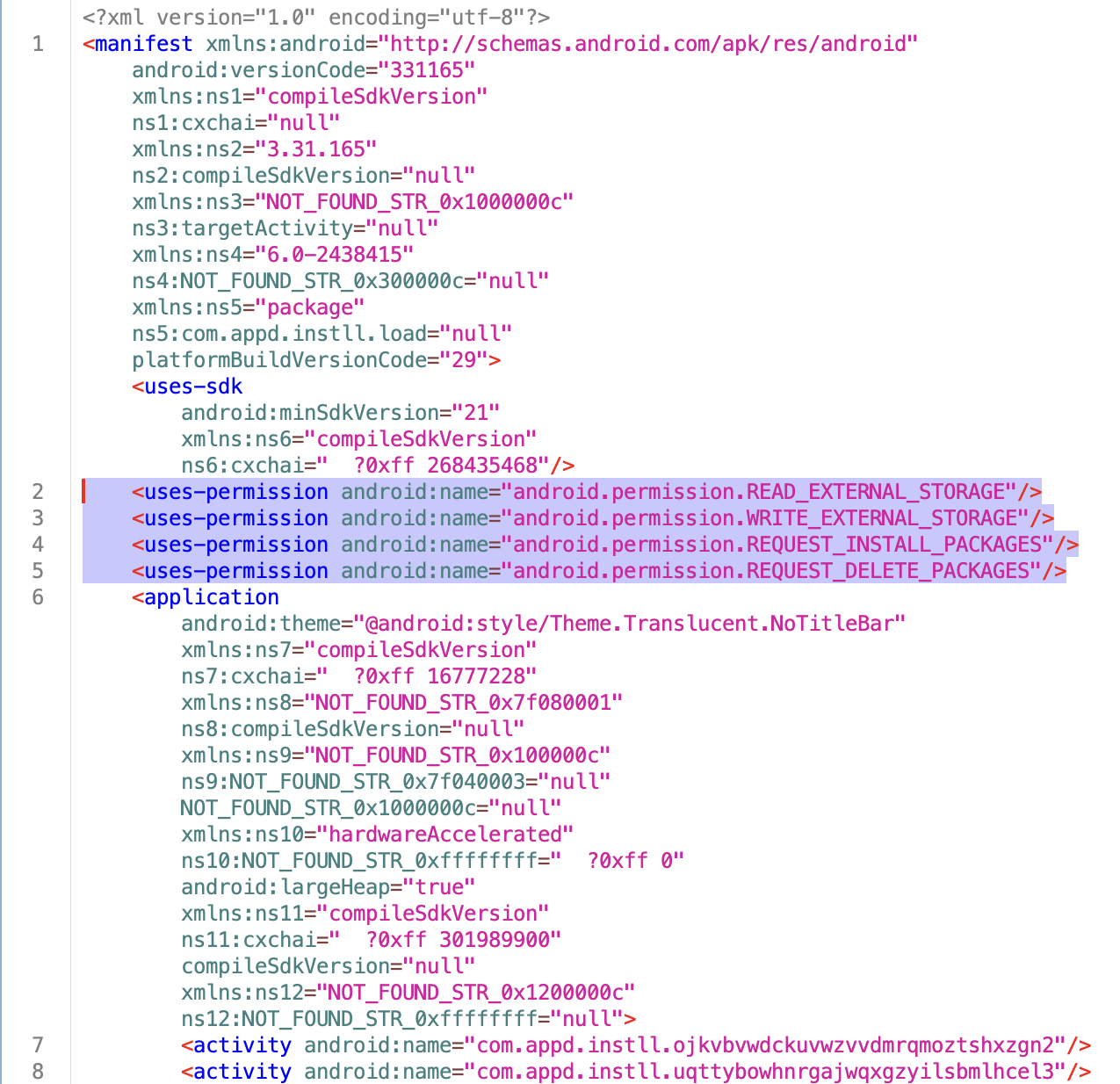
Following the entry point provided by the AndroidManifest.xml, it is clear that there is another APK hidden in the assets/childapp.apk. The first APK will prompt the user to install it after launching.

Unsupported Compression Algorithm
If you are trying to unzip this APK, you may encounter an issue where the AndroidManifest.xml can not be extracted due to the unsupported compression algorithm. If you open it with 010Editor, you will notice that the compression method in the Central Directory File Header and the Local File Header has been modified, which leads to this error with the unzipping tools. The correct value for the compression method should be STORED (0x0000), and you can simply use 010Editor to correct it.


Incorrect Magic Number
After solving the previous issue, you should be able to decompress AndroidManifest.xml successfully. However, you may notice that Jadx is still unable to read it properly, and 010Editor cannot recognize this file as AndroidManifest.xml. This usually indicates that the magic number in the file has been modified. According to the definition, this value should be 0x0003.

Incorrect stringCount in strPool
If 010Editor is still unable to parse the entire file correctly, it may be due to an incorrect stringCount value in the string pool. If the total number of the stringoffsets differs from the value indicated by the stringCount, 010Editor will fail to parse the rest of the content.
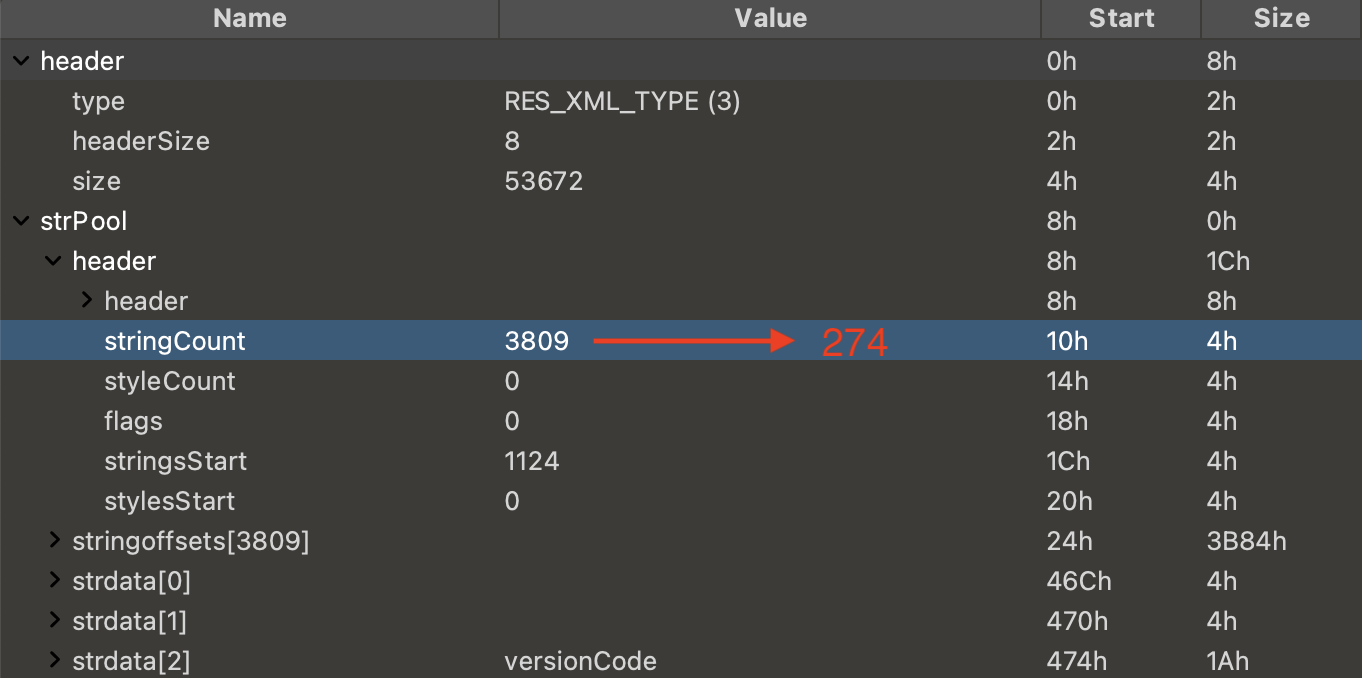
To get the total number of strings (stringCount) in this file, we can do some simple calculations based on the diagram as shown in the screenshot below. The header is 8 bytes, the StringPool_header is 28 bytes, and the first string starts at position 46Ch (1132 bytes). By subtracting the sizes of the header and the StringPool_header from the starting position of the first string, we can get the total size of the stringoffsets. Since each stringoffset is 4 bytes, dividing this total size by 4 gives us the number of stringoffsets, which is the value of the stringCount. The calculation of the stringCount is as follows:
stringCount = (starting position of the first string - header - StringPool header) / 4
274 = (1132 - 8 - 28) / 4
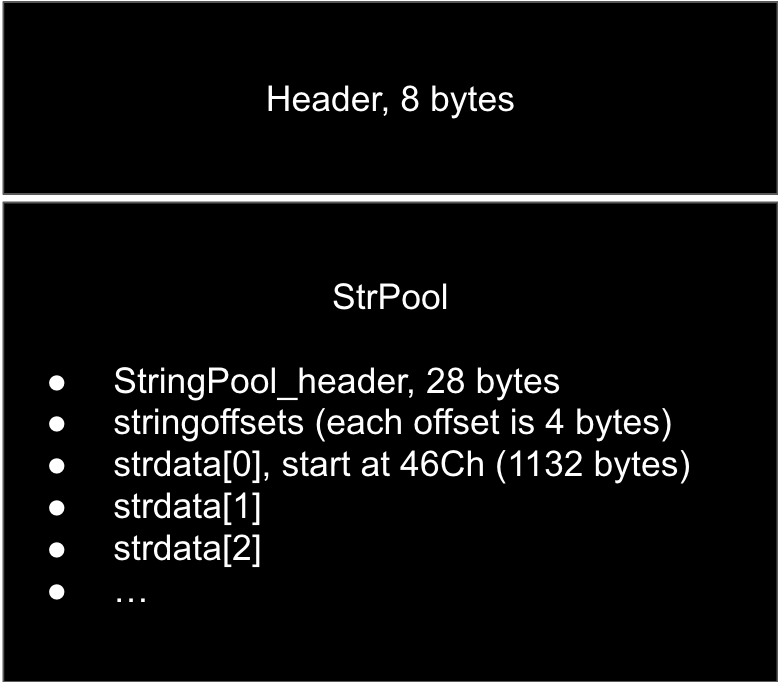
Next, you may notice the same issue with unexpected attribute sizes that we discussed earlier. Since we’ve already covered it in detail above, we won’t go over it again here.
Incorrect Size of the Namespace End Node
In addition to the techniques we discussed in this SpyNote sample, we have found another sample from public Triage that uses a less common technique during our investigation. This specific technique involves changing the size of the namespace end node from 24 to 0. This results in 010Editor continuously generating a large number of namespace end nodes. As a result, this could potentially cause some reverse engineering tools to crash due to running out of memory.
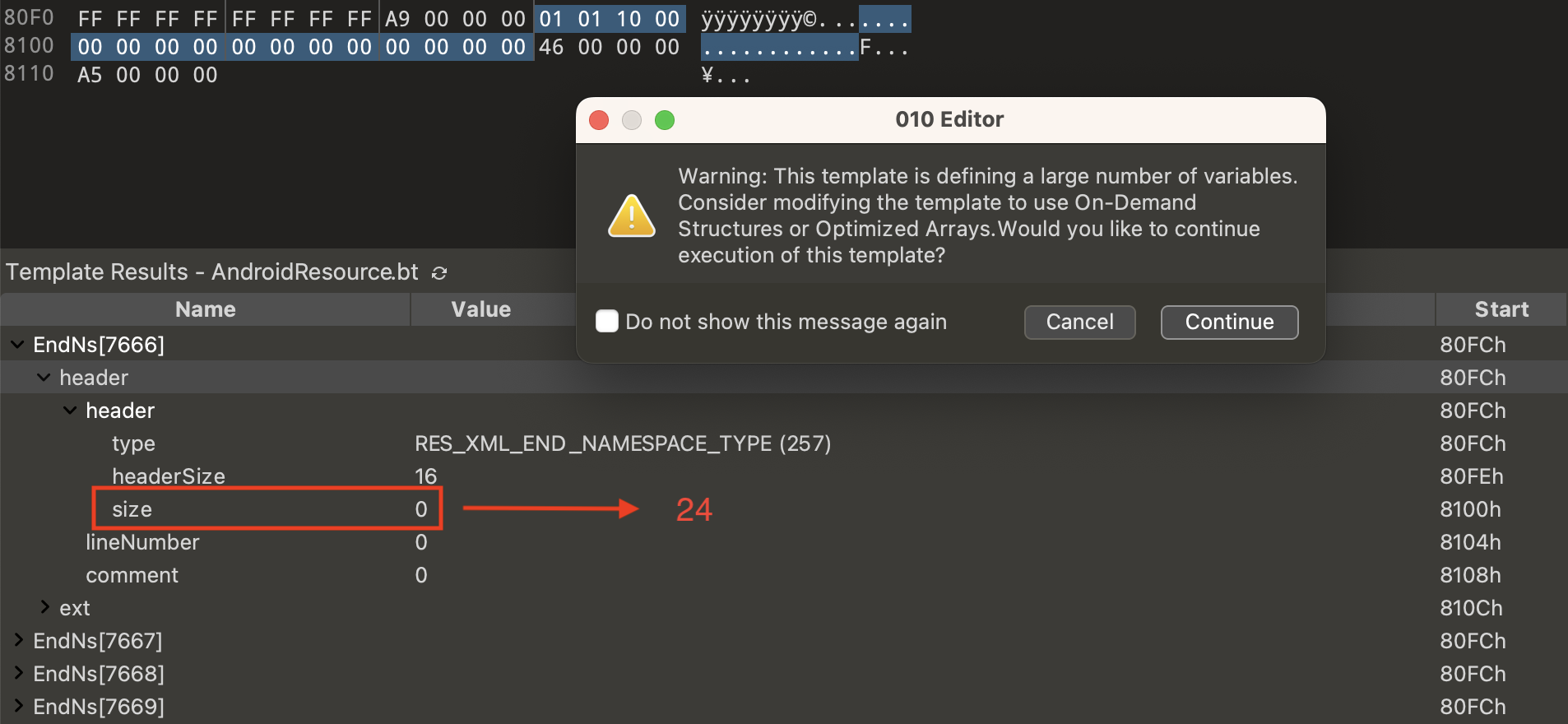
Conclusion
In this blog, we have delved into several anti-static analysis techniques for the SpyNote sample in detail. These techniques rely on differences in how strictly reverse engineering tools and the Android system interpret the APK and AndroidManifest.xml formats, allowing malware developers to abuse the variations. By abusing these techniques malware can evade most static analysis tools, posing additional challenges for malware analysts while still being able to infect Android devices.
To mitigate the above techniques, two strategies can be used. First, analyze the APK and AndroidManifest.xml to ensure alignment with the Android system. Second, manually identify the modified places of the malware and make the necessary corrections.
By leveraging Triage, you can efficiently extract all the necessary information from our static report. We’ve already streamlined the process of retrieving content from malformed Android applications, minimizing your effort. It is particularly helpful and handy when dealing with a large volume of malware. Additionally, we now have a static signature for detecting the above anti-static analysis techniques, which can be valuable for flagging and hunting potential malware.
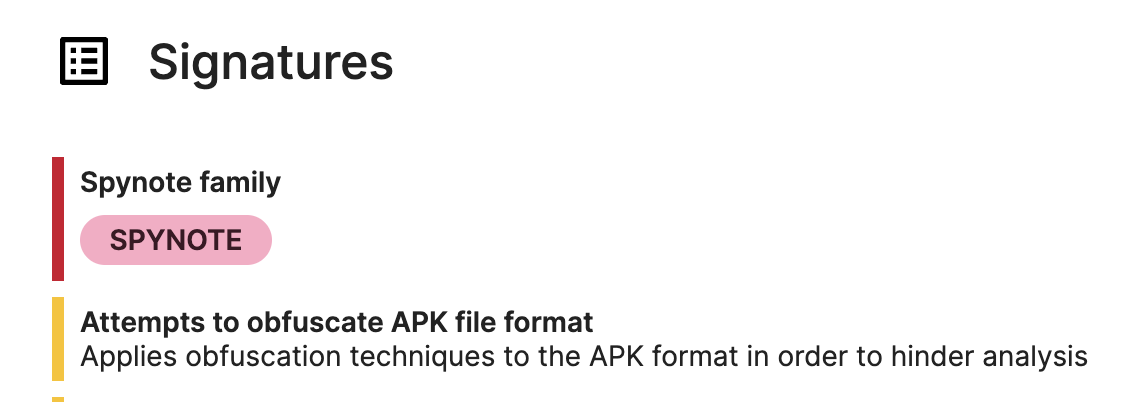
IOCs
C2 (found in the sample 240121-qevpsadbfl we analyzed for this blog)
147.185.221.17:59471
All SpyNote sha256 with unsupported compression algorithm from public Triage (as of July 24th 2024)
0b5bf913394d5d9d31faa90a592226dd14743d9413654ac94a3db2c92e7954bb
1cab0e8d2c1a8665bf293b4046663ab9fda7158883b19087e7c4fa56fd01acf3
1cf7f29893278dd351f11a658f6c88568738352ffa155f38369fc58bf7391fce
1e4a3f8cf9fce285d0fcaa00501bfc79a3b1c76417a61751ef2a6a5d04e69479
23a2728a3ecf335d03f15bb9ac4d1d2a6f8c83c43bc97417fcbbd364de45e82b
25cdf9a99523090949674110c7d11cba1f4c04b4b58256b4b3a6402316e54423
26f0a9ba3832d464e2b26ad4f30b0e431221fbb99081ec0c833fa00976446023
2a5fff5ad2bfcb1aeac3ddb569e46925de0501f666e7ef26c84eeeca7cd3f7cf
370b6ae6a25f25cca531c30d46e951e04799f0ca8c1e8c635d9bc6c3b4edac49
3ff998d884cda14fed17a012c566fe04e9607889945b713ea526f3323e95e401
50ed3f937dd66716c7b87efd3582a67e0f8ab697ebad09bec564de3f8be5baa8
62dc94aff3ef3bdfc71f6810675da9150e8d63750af6db8573f2924e9e7bd863
769799932334e5bfbf1c3f62ac1a9ce0b21d112c4d9723f954984f67578d1bc8
7e24005f8d2db9cc74bac68dccfd671e2262bbbeaed77507f4dadfb4641f3b15
8ed6f4d9f53493d495da440a24cff2d4145e806f4be2327125b9c5199b87fdc7
94f4ec6dab1d8f4636a37968fd096b4e0a2857e89c950122796836d1102523ba
d96c0056cc8e3511759b5682e14ac826242613e8b4cf8fee59541bde6df2ea33
dbf31c290b84e90673a4253890da1e53fe946ff352b369dabc826df07ad638d5
e4467183762bafa0735fb45d0ea93678e20fb97d9988fbdaad5032bf2b579ce3
eda54419b9aceef6b2e5c7c627154976342cdcad860973310d4fa1f85901340a
eeb07f5f8f2baab9e5888bfad55b66819b5b0ba1c3c516eea0dad165f2146839
ef970f55ece429903b5b9cbb4f066071c03ebf0423dce069b177f3391f92e3bb
f36e8eed67bdd992bf9ffa85f7d9fa9dd504ec74f4e0e69f0997f598ca3c8ff6
fecaa5676e35c4ef767471e9db67b37c700f9ac2903e731817a1cb1cb299796b
